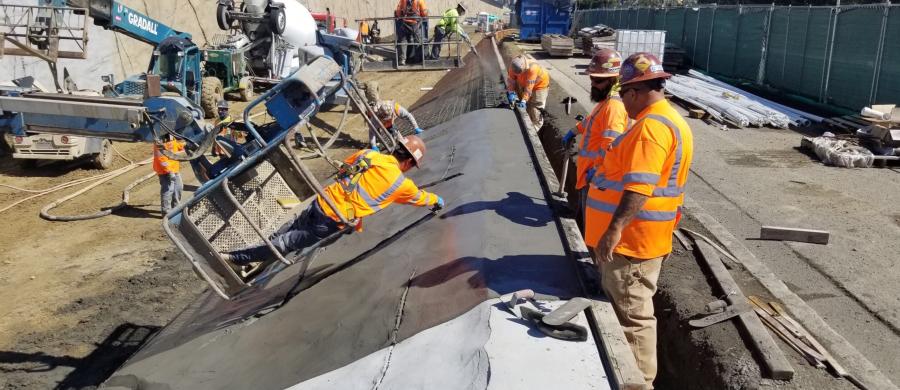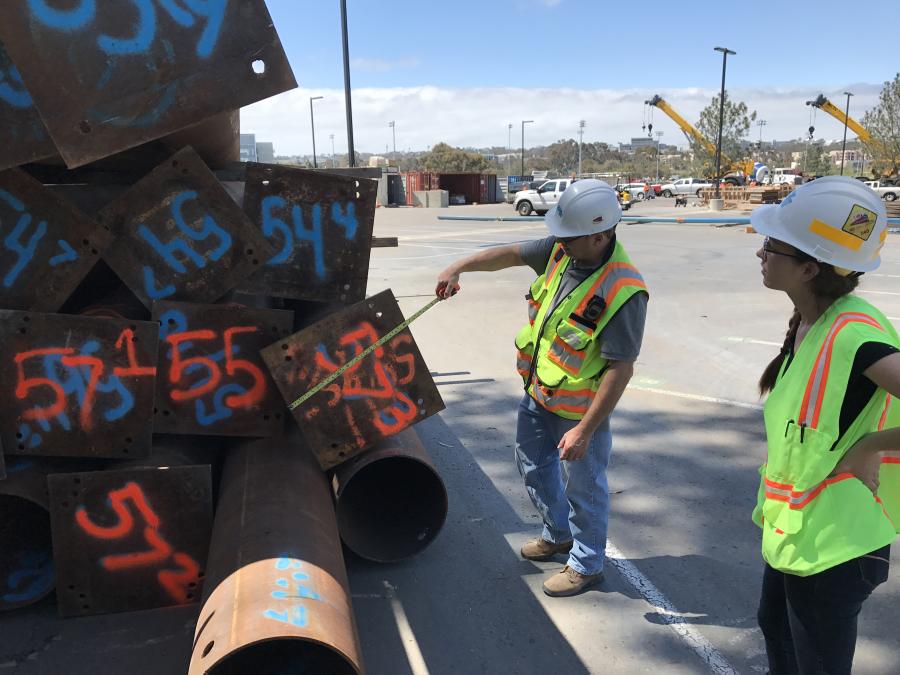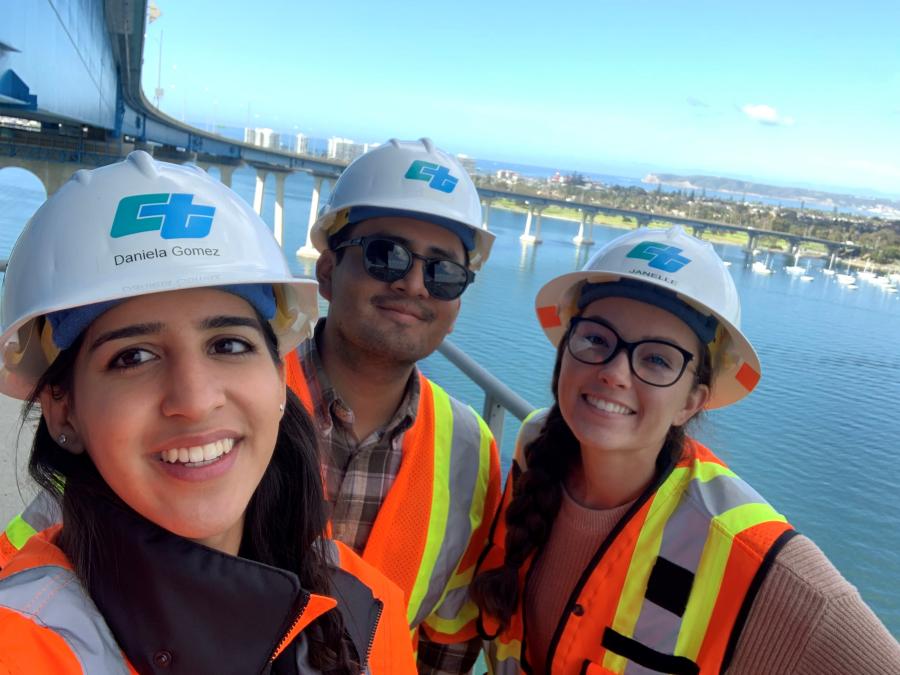Photo courtesy of Caltrans
(L-R): Daniela Gomez, Carlos Guzman and Janelle Clanton, of Caltrans.
More and more women are entering the ranks of the construction industry — including heavy civil construction — and in honor of International Women's Day that was celebrated on March 8, Janelle Clanton, a transportation engineer with the California Department of Transportation (Caltrans) District 11 that covers San Diego and Imperial Valley counties, sat down for a Q&A discussion.
Born and raised in San Diego, Clanton, 28, while officially a transportation engineer, on the work site takes on the role of Resident Engineer/Structure Representative, which has her involved in daily construction activities, working with general contractors to ensure that projects are delivered on-time and on-budget and are solidly built.

Photo courtesy of Caltrans
Clanton feels right at home on bridge and road construction sites, but unlike many who have family that are or were employed in the sector, there was no guarantee that construction would be her career choice. It was an appreciation for math and being good with numbers that attracted her to engineering and brought her into the construction orbit.
Clanton graduated from San Diego State University in 2017 with a Bachelor of Science in civil engineering, a four- to five-year program. Her introduction to construction began during her third year of university when Caltrans District 11 brought her on board as a Student assistant, a role she fulfilled for 1.5 years. The DOT, recognizing good talent, hired her as a full-time employee upon graduation.
The rest, they say, is history, and Clanton who is very at ease on construction sites and the building process, was on her way to a bright future within Caltrans and serves as a role model and inspiration for other women to follow in her footsteps.
In the Q&A below, Clanton recounts her journey to construction, her fascination with it, and why women should look upon the sector as a rewarding career choice.
CEG: When did you realize that you had a flair for math and numbers and logic and desired a career that would play to your strengths?
Clanton: My dad, with all of his five children, would always quiz us with quick math problems and fast thinking while we were growing up. I would say all of us have a flair for math and numbers, but I wanted to make a career out of it because it came more naturally to me all throughout grade school than other subjects like history or biology. I like to think that I've always been a logical person, so these strengths made engineering an easy choice.
CEG: What led you to study engineering and in particular, civil engineering? Did any of your professors have any experience in construction and with general contractors?
Clanton: When I was applying for college, I hadn't completely made up my mind about what I wanted to major in. I had thought, at many points in my life, that I might want to be a math teacher or something like that. Instead, I researched different careers for people who like math, and engineering came up over and over again. Civil engineering seemed like the obvious choice for me because other engineering disciplines didn't interest me as much when I was looking into what they all did. Civil engineering has so many options career-wise. A few of my professors had currently or previously worked in construction or with general contractors and introduced the concepts of construction in our classes.
CEG: What led to you becoming a student assistant with Caltrans and did you have a feeling that you would be asked to join the DOT? Since you were hired, how would you describe your experiences and what are some of the projects that you have worked on?
Clanton: I took a class in college — Surveying — which I like to think I did pretty well in. I worked hard and so at the end of the semester I asked one of the professors if I could list him as a reference for future job applications. He said yes, and also mentioned that Caltrans' Surveys department was looking for a couple of student assistants to help out one of their engineers. I went through the interview process and luckily got the job. I've worked hard since then and had my fingers crossed that Caltrans would want to hire me full-time (luckily, I got that opportunity). Since my start, I have worked in surveys, structure construction, district (roadway) construction, bridge design and geotechnical services on a variety of projects. I'm definitely not a designer, but something about construction – seeing the work and progress from start to finish, and being a part of it — has been the most fun for me so far.
Some of the projects I have participated in are: The Gilman Drive Overcrossing Arch Bridge over I-5 (near UCSD); the Roadway Compaction Grouting Emergency Project on SR 52 (near Convoy Street in Kearny Mesa); the Mid-Coast MTS Trolley Extension over I-5 (near UCSD/La Jolla), which included two stand alone bridges, one multi-span bridge, multiple retaining walls and a tunnel; the I-8 / SR 67 Bridge Deck-on-Deck Emergency Project on I-8 (in El Cajon); and the I-8 Multi-Mile CRCP Construction (in Imperial County from El Centro to Yuma).

Photo courtesy of Caltrans
CEG: Your knowledge of construction materials, stress points for infrastructure, construction techniques, ability to read construction plans and administer them continues to improve. Is this a combination of information you learned in classes and on the job sites?
Clanton: College, while giving me a great base of knowledge at the beginning of my career, definitely could not teach anyone everything they need to know about how to do their job. Caltrans is great about offering job-specific training and I've also done my fair share of on-the-job training with colleagues who have more than 30 years of experience. In my position, we deal with so many different types of construction materials and techniques that you do have to put in the work to fully understand some of them. I am constantly learning new things, relearning things that I haven't seen for a few years, and also teaching others with less experience than me. All of that contributes to the knowledge and abilities I now have and use every day, and I'll continue to add to that knowledge for the rest of my career.
CEG: To what extent are you still learning about heavy civil construction and how would you describe your work on job sites and with general contractor teams and design and engineering firms?
Clanton: As I mentioned, I learn every day! In my current position, I am somewhat of a middleman between designers and general contractors, and it's up to me to make sure that the project plans are being interpreted and implemented correctly. Sometimes, I get it wrong, or have to consult others — including designers, colleagues or the contractor themselves. Nobody knows everything and the most important thing is getting the project completed on-time, on-budget and correctly. In order to do this, there has to be a good working relationship with all parties.
CEG: As a woman, are you accepted in an industry that is still male dominated to a large extent?
Clanton: I've never had any issues as a woman in engineering/construction. Caltrans is quite diverse, and is a great workplace — I'm treated the same as any of my male colleagues. I've encountered other women throughout the different disciplines of engineering, within Caltrans, and through general contractors. There are many women within positions of authority, and we keep the projects running smoothly.
CEG: Would you encourage women to consider engineering and construction, be it as laborers, equipment operators, and project management? When you studied engineering, were there many women taking courses?
Clanton: Absolutely! Many women I've met who are in engineering or construction are doing really well, and enjoy what they do (myself included). That there are fewer women in engineering/construction than men just means that we need more women! I've had plenty of colleagues and a few supervisors who have been women, and each of them have been great at teaching, collaborating and getting things done. Although I'm only 6-plus years into my career, I've had the pleasure of introducing new hires and mentoring them to the best of my ability. When I was studying engineering, there were definitely more women in engineering majors than I had expected, which was a pleasant surprise. Since I've graduated, other women that I've spoken to have had similar experiences. CEG
Today's top stories
























